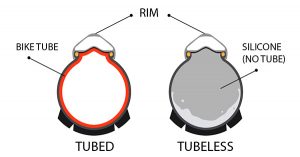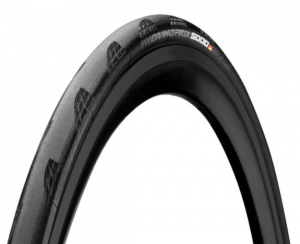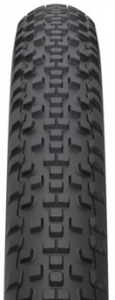Jim is an accomplished triathlete and endurance cyclist, and has raced in more than 35 USAT-certified races. He is also an avid trail runner and endurance gravel bike rider. Jim is a founder of Complete Tri and frequent writer on triathlon and cycling.
Tubeless bike tires (or ‘tyres’ for our friends in the UK) first hit the road bike scene in 2006, when Shimano and Hutchinson both created a market for them, but they had been around for a few years before that in some niche mountain bike circles. Adoption was slow at first, but in recent years cyclists have begun to buy-in to the idea of riding a tubeless tire. Especially since about 2017, the number of tubeless bike tires found both on bikes as well as in bike shops seems to have really taken off.
We were some of the people who were hesitant to use tubeless tires at first. We were just so used to the old types of clincher tires, and had become quite good at changing tubes when we got a flat, that it was hard to move away. Old habits die hard, as they say.
But we are part of the bandwagon that is now giving tubeless bike tires a good look, and depending on which of our bikes you inspect, you actually will find us riding some tubeless tires right now!
How Do Tubeless Bike Tires Work?

A tubeless bike tire works just as it sounds — the tire mounts directly on the rim, with no need for a tube. Cars and motorcycles have been using them for years. Cycling is finally getting with it too.
Typical bike tubes serve a few functions, most notably to hold the air that keeps a tire inflated. Because a tubeless tire does not require a tube, it is designed to seat directly on the rim and create a full, airtight seal. Because a tubeless tire needs to be a little thicker with an extra, very thing layer of sealing membrane, it might be slightly heavier than a clincher or tubular tire. However, that different may likely be made up by the lack of a tube (at least in the case of a clincher).
The other important thing that a tube does is supply a secure, sealed place for the air valve to reside. Without a tube, valve placement and quality can be important, but if done right you can expect each valve seating to last as least as long as a tube would. In a tubeless tire setup, the valve stem is really part of the rim, not part of the tube.
What are the Advantages of a Tubeless Bike Tire?
The first advantage is probably obvious based on the name of the tire: No tubes. Without a need for tubes, your bike repair station has one less part to stay stocked-up on. Not having tubes also reduces the chance of pinch flats, something that really doesn’t happen on either a tubular or tubeless tire. Pinch flats are something that is unique to the clincher because of its inherent design.
On that last note, you should experience fewer overall flats with a tubeless tire. Pinch flats are only part of the reason. Tubeless setups also have a built-in sealant that allows minor flats to be sealed on-the-fly, due to the construction of the tire. So, while getting a flat with a tubeless tire might be a big deal, you should get way fewer flats overall. Who doesn’t want fewer flats?
Gravel bikes, in particular, are trending harder toward tubeless tires being the standard, for the very reason of pinch flats. To get the right traction, and to reduce vibration on some gravel roads, riders want to ride those bikes at lower air pressures. Lowering the air pressure in bike tire is a main cause of a pinch flat, so it is natural that anyone relying on lower pressures at times is pretty eager to eliminate the tube from the equation.
A third advantage of going tubeless is that today’s manufacturers seem to be investing more of their R&D money into tubeless designs, so we expect these to increasingly be the highest-tech tires out there as we go forward.
Finally, we like that a tubeless tire, because of its design with thicker membranes and added sealant, is less likely to experience a sudden flat on the middle of fast segment, which can be potentially dangerous to the rider. Instead, a tubeless tire tends to lose its air slowly, allowing the rider to more safely navigate to a good stopping spot.
Are there Disadvantages to a Tubeless Bike Tire?
Yes, there are a few.
First, a tubeless tire and the rim it goes on typically cost more than the old-fashioned clincher or tubular tires. They involve a bit more engineering, and you have to pay for that. Still, for most gear junkies, the cost difference probably won’t be enough to dissuade a conversion to tubeless.
Second, a tubeless bike tire requires a valve stem that is seated perfectly with no imperfections. If there is anything about it that doesn’t seal, it is going to leak and you won’t have an inflated tire. Contrast that with a clincher tire, where as long as you are using a newer tube that is in good shape, your valve stem will probably be just fine.
Lastly, a road flat with a tubeless tire involves a few new supplies that most of us clincher riders aren’t that familiar with, namely some sealant. With a clincher, carrying an extra tube or two is really not a big hassle, and most of us have gotten pretty good at quickly swapping a tube. Little secret, though — you can always stick a tube in a tubeless tire just so you can get home. It means you will potentially burn a good tube just to get you back to safety, but it is better than being stranded.
On the flip side, you will hopefully have fewer overall flats because the pinch flat will no longer be a thing.
What Happens if you Get a Flat with a Tubeless Tire?
For starters, you should get fewer overall bike flats if you are riding a tubeless tire, because of the tire’s self-sealing construction, added sealant, and the fact that you won’t have any pinch flats. But that is a bit of a non-answer to the question at hand.
If you do get a flat with your tubeless tire, you can sometimes fix it trailside or roadside, but it involves carrying some sealant with you.
- Remove the tire just as you would with a clincher tire
- Inspect the tire, rim tape, rim, and valve stem. If you can’t see any problems, it is possible that you lost your seal and re-installing the tire with new sealant could do the trick.
- If you think there is an issue with the tire’s ability to seal, or your valve stem is leaking, then you can always throw a tube in just so you can finish the ride. In this case, fix the wheel back in your workshop or garage.
More and more makers have unveiled lightweight and compact repair kits that you can travel with on your bike, so be sure you have a couple on hand if you decide to convert to tubeless. We like the full kit from Stan’s, here on Amazon.
Really not that big a deal when it comes down to it, and just like when you first started learning how to change a clincher way back when, a little practice in the safety of your garage will go a long way when you have that first road flat and need to fix it.
Can You Use a Tubeless Tire on Any Rim?
Technically, yes. But some require a workaround.
A tubeless-ready rim is a rim that is setup for tubeless tires. You will know if it is tubeless-ready, because the manufacturer will say that in the marketing materials, and it will probably be stamped on the rim. The rim will also cost more!
If you have a tubeless-ready rim, you are good to go.
A regular old clincher rim can also work, but it will require two modifications in order to accommodate a tubeless tire. First, you will need rim tape to create a smooth, sealable surface on the rim, and especially cover-up any spoke holes in the rim bed. This is a job that is not difficult or expensive, but take our time to do it carefully in a clean spot without debris around. We like Stan’s Rim Tape (here on Amazon).
Second, you will need to be able to add a valve stem to the rim — because remember you won’t have a stem in the tube. This also requires a careful installation to make sure it seals well. Again, not a time-consuming job, but don’t rush it. Here again, we like Stan’s product — the No-Tubes valve stem (here on Amazon).
Best Tubeless Bike Tires
Best for Road or Tri Bikes: Continental Grand Prix 5000
We have always loved the tires that continental makes. The brand shows up all over in our piece on the best road bike tires. It stands to reason that our favorite tubeless tire for road or tri bikes right now is also from Conti.
The Grand Prix 5000 is a great all-around tubeless road tire that clocks in at 25mm, making it narrow enough for road bikers who prefer skinny, slick tires.
Don’t let the slick look fool you, though. We find the Lazer Grip technology to have good traction for a slick, allowing you to ride with the control you need. The tire installs well, and the bead tends to set reliably on the first try.
They aren’t cheap, but they are good. If this is your first foray into the world of tubeless road bike tires, we’d use these. Find them here.
Best for Mountain Bikes: Maxxis Minion
The Maxxis Minion is a great all-around mountain bike tire that gives you a great tubeless option. 
The knob design gives you a smooth roll while also providing firm and high-traction trip when you need it. We like how the construction gives the tire stronger sidewall strength — the last thing you need is your tire failing on a downhill.
At 870 grams, the weight is competitive, but with mountain bike tires it all comes back to the grip, and the Maxxis provides the best grip we have found for the tubeless money. Find it here.
Best for Gravel Bikes: WTB Resolute
Gravel bikes require a true hybrid of a tire — something that rolls with ease, but has just a little grip with you really need it. That is why we like the WTB Resolute.
This one is a little more aggressive than what we often ride (we usually err on the side of being slicker than most gravel riders), but it is really a great all-purpose gravel tire. It will roll very well when you are on the hardpack or even the pavement, but when you get on a greasy trail it has enough teeth to keep you upright and in control.
The true test of a gravel tire is if you keep traction and control when going uphill in loose gravel, and these pass that test. They are 42mm wide, so be sure they work with your bike setup. Find it here.
Best for Fat Bikes: 45NRTH Dillinger
Answering the question of the best tubeless tire for a fat bike is really tough, because conditions can vary so much. Are you riding on a snowy trail or pure ice? Perhaps you are not a winter fat biker at all, but rather use yours to ride in sand on the beach. Are you trying to pick-up some speed on safe conditions, or is your goal to stay upright on a really gnarly surface? Each of those situations calls for a different tire. That is why we did a more extensive buying guide for fat bike tires.
Let’s assume that you are a winter fat bike rider like us. Then, our favorite and most durable fat bike tires comes from the Minnesota company 45NRTH. The Dillinger is a great all-around tire with aggressive studs, perfect for rides when you might be hitting ice or hard-packed snow. On pavement, these are loud tires that will create some drag, but that isn’t why you buy them. You buy them so you can power over surfaces that would cause most cyclists to wipe out in a split second. Find the Dillinger here.








Tubeless tires were in use around the early 1900’s following solid rubber and preceding contemporary clincher/tubed types. A nod to history is being overlooked here.